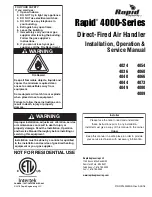
5169032-UIM-C-0416
Johnson Controls Unitary Products
9
SECTION VI: REFRIGERANT LINE
CONNECTION
Connect lines as follows:
1.
Suction and liquid line connections are made outside the cabinet.
Leave the tubing connection panel attached to the cabinet. Coil
access panel should be removed for brazing. The lines are
expanded to receive the field line set tubes for most outdoor unit
matches.
2.
Remove grommets where tubes exit the cabinet to prevent burning
them during brazing. In some units, the vapor line grommet may be
shipped as a loose part with the unit. Refer to Figure 15.
3.
Cut the end of the suction tube using a tube cutter. Place the tube
cutter as close as possible to the end of the tube to allow as much
depth as possible for the connection and brazing of the suction line.
To ensure suction line fits into connection, deburr the stub out
(including inner pressure protrusion from cutting).
4.
If coil does not have a factory installed TXV, install the required size
piston or TXV kit. See coil metering devices section for detailed
instructions.
5.
If the coil does have a factory installed TXV, remove the liquid line
copper cap which is soft soldered onto the outside of the 3/8” stub
protruding from front of the coil cabinet tubing panel as follows:
a.
Screw a sheet metal screw into the center of the cap.
b.
Apply a small amount of heat to the cap while pulling on the
screw using slip joint pliers.
6.
Insert liquid and suction lines into the coil connections at the coil
cabinet tubing panel.
7.
Wrap a water soaked rag around the coil connection tubes inside
the cabinet to avoid transferring excess heat to the coil or TXV.
8.
Purge refrigerant lines with dry nitrogen.
9.
Braze the suction and liquid lines, and allow the joints to cool.
10. Route the TXV sensing bulb through suction line opening.
11. Secure sensing bulb and equalizer line capillary tubes with nylon
cable ties to prevent leaks from tubes rubbing.
12. If piston is used, install Schrader core into suction header, and rein-
stall cap.
13. Re-attach the grommets to the lines carefully to prevent air leak-
age. In some units, the vapor line grommet may be shipped as a
loose part with the unit. Refer to Figure 15.
14. Attach the coil access panel to the cabinet.
15. Refer to Outdoor unit Installation Manual, and accomplish evacua-
tion, leak check and charging instructions. Check all field brazed
joints and metering device connections.
16. Ensure lines are sound isolated by using appropriate hangers or
strapping.
SECTION VII: CONDENSATE DRAIN
CONNECTIONS
All drain lines should be trapped a minimum of three inches, should be
pitched away from unit drain pan and should be no smaller than the coil
drain connection.
Route the drain line so that it does not interfere with accessibility to the
coil, air handling system or filter and will not be exposed to freezing
temperatures. See Figures 19 & 20 for drain connection locations.
If the coil is provided with a secondary drain it should be piped to a
location that will give the occupant a visual warning that the primary
drain is clogged. If a secondary drain is not used it must be plugged.
Instruct the owner that the evaporator coil drain pan should be
inspected and cleaned regularly to prevent odors and assure proper
drainage. If a secondary drain is not used it must be plugged. See
Figures 19 & 20.
CAUTION
Coil is under inert gas pressure. Relieve pressure from coil by
depressing Schrader core at end of suction manifold stub out.
CAUTION
Dry nitrogen should always be supplied through the tubing while it is
being brazed, because the temperature required is high enough to
cause oxidation of the copper unless an inert atmosphere is provided.
The flow of dry nitrogen should continue until the joint has cooled.
Always use a pressure regulator and safety valve to insure that only
low pressure dry nitrogen is introduced into the tubing. Only a small
flow is necessary to displace air and prevent oxidation.
NOTICE
Avoid handling aluminum coil components after handling the copper
line set or other tubing without first cleaning hands.
NOTICE
Route the refrigerant lines to the coil in a manner that will not obstruct
service access to the coil, air handling system, furnace flue or filter.
NOTICE
All indoor coil connections are copper-to-copper and should be
brazed with a phosphorous-copper alloy material such as Silfos-5 or
equivalent. DO NOT use soft solder.
!
!
FIGURE 15:
Vapor Line Grommet
CAUTION
DO NOT use Teflon
TM
tape, pipe thread compound, or other
sealants. The use of a sealant may cause damage and premature
failure of the drain pan.
Threaded drain connection should be hand-tightened, plus no more
than 1 turn.
Avoid Double Trapping of a single drain line.
CAUTION
When the unit is installed in an attic or above a finished ceiling, an
auxiliary drain pan should be provided under the coil as specified by
most local building codes. When this exterior secondary drain pan is
used that drain should be piped to a location that will give the occu-
pant a visual warning that the primary drain is clogged.
$
*5200(7
)RU9DSRU/LQH
!
!





































